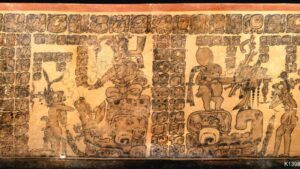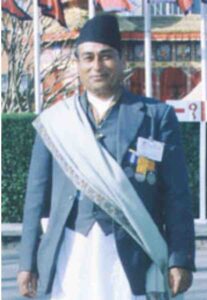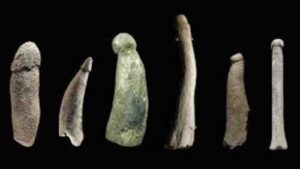Unexpected Things Found Unexpected Time Periods
Summary
Ultimate Fact presents the Top 10 Unexpected Things Found in Unexpected Historic Time Periods. Most of us think that we have a handle on history. We know what to expect from various time periods and have a clear mental image […]

Ultimate Fact presents the Top 10 Unexpected Things Found in Unexpected Historic Time Periods. Most of us think that we have a handle on history. We know what to expect from various time periods and have a clear mental image of the past. It’s a mental image that wouldn’t include comic books in Mayan times, dildos in ancient Egypt, or Jewish-American schoolchildren giving Nazi salutes in 1934.
Well, guess what? All those things existed in those time periods. While there’s a perfectly rational explanation for all these incongruous things, it does make you wonder whether history is as linear as we think it is.
Video: Unexpected Things Found Unexpected Time Periods
Comic Books in Mayan Times
He’s a tall, cheeky cartoon rabbit with his own catchphrase and laconic wit who constantly outfoxes his clueless enemies. No, we’re not talking about Bugs Bunny. We’re talking about the star of some of the oldest comic strips in the world: the strips written by the Maya.
Plenty of ancient cultures used images to communicate ideas, but Soren Wichmann at Leiden University in the Netherlands maintains that it was the Maya who first developed recognizable comic books.
Dating from as early as 650 BC, their drawings contain plenty of motifs that we associate with modern comics. Speech is contained within speech bubbles; smelly things have stink lines hovering above them; motion is represented in an eerily similar way; and there are characters recognizable to a modern audience.
The most recognizable of these is the trickster rabbit, dubbed by Wichmann as “the Mayan Bugs Bunny.” Like Bugs, he’s flippant, irrepressible, and loves getting into scrapes. Like Bugs, he even has his own catchphrase, although “smell your sweat, wizard penis” is admittedly a long way from “eh, what’s up, Doc?”
According to Wichmann, these early comics were highly valued in Mayan times and used as status symbols. A modern comparison would probably be wealthy nerds proudly displaying their mint copies of Action Comics No. 1 in their living rooms.
Video: Unexpected Things Found Unexpected Time Periods
Mass Shootings in Schools in the 18th and 19th Centuries
Sandy Hook, Columbine, Virginia Tech, Umpqua—the list of mass shootings in American schools is long, gruesome, and frighteningly recent. Even the most historically minded would probably trace such random incidents back no further than 1966, when Charles Whitman shot and killed 17 people from a tower at the University of Texas.
While it’s true that modern weapons can make mass shootings deadlier today, they are far from a modern phenomenon. Look through the history books, and you’ll find school massacres in America dating back as far as 1764.
That was the year that four Native Americans from the Delaware tribe entered a classroom in Greencastle, Pennsylvania, and gunned down 10 children along with their teacher. Then they scalped their victims. Historically considered part of the Pontiac Wars, this first incident was different in motivation than modern mass shootings.
But the ones that followed weren’t. In 1891, an elderly man took a shotgun and randomly fired it into a crowd of boys playing outside a school, injuring dozens. Remarkably, it was only one of two random shotgun massacres that year.
Read More: Top 15 Things Rich People Do
Government Psychics and Astrologers in 2005
Not all the incongruities in history involve something modern turning up in the past. Occasionally, things that we thought we left behind ages ago surface in the here and now. As recently as 2005, Nepal’s royal family had an official astrologer whom the government consulted about major decisions.
Known as Mangal Raj Joshi, this astrologer came from a long line that had served Nepal’s kings for 16 generations. They probably would have continued serving them longer, too, if Joshi hadn’t died and the monarchy hadn’t been forced to stand down by a massive rebellion.
In his official capacity, Joshi was tasked with picking auspicious days for ceremonies and making predictions that would influence how the country was run. Nonetheless, he didn’t predict the biggest event of his tenure: when Crown Prince Dipendra massacred 11 members of the royal family in a dispute over his bride.
If this sounds ridiculous, bear in mind that it isn’t only places like Nepal that have officially flirted with discredited sciences. There’s a longstanding accusation that Ronald Reagan was making policy decisions as late as 1988 based on advice from his wife’s astrologer.
Official Dream Interpreters in the British Empire
Like astrologers, dream interpreters once took an active part in how countries and kingdoms were run. But you probably wouldn’t expect to find them working in an official capacity in the 20th century, especially not in an empire as interested in science as Britain’s.
During the interwar era, though, that’s exactly what you would have found. In the 1920s, Britain hired dozens of dream interpreters to officially help set the direction of the entire empire.
The caveat here is that the interpreters weren’t schooled in ancient mystical arts but in a modern one. Psychoanalysis was taking the world by storm, and the British government thought they could use it to their advantage.
As nationalist sentiment began sweeping the colonies in Africa, the Middle East, and India, the British hoped to analyze their subjects’ dreams and locate the source of anticolonialist feeling.
Amazingly, it worked. Sort of. A massive group of researchers spent nearly two decades diligently recording dreams in places like Sudan, Nigeria, India, and Australia and analyzing them from a Freudian perspective. There was one consistent motif: White British men stormed into their subjects’ dreams and attacked them.
To their chagrin, the British discovered what many had known all along: If you conquer someone’s country, enslave their relatives, and rule by force, they will probably hate and fear you.
Nazi Salutes in 1930s American Schools
A gang of Jewish-American schoolchildren being encouraged to give a Nazi salute to the Stars and Stripes in the 1930s sounds like a badly misjudged joke from an edgy, racial comedy. But that’s exactly what this photo shows. Taken in 1933 or 1934, it comes from a time when Mussolini had been doing the salute for over a decade and Hitler was just starting to climb onto the world stage.
In light of the above, you might be wondering why American kids—and specifically Jewish Americans—would want to give a Nazi salute to the flag. But there’s a good reason. It wasn’t a Nazi salute at all. By rights, it should be known as an American salute.
The stiff-armed salute that we now associate solely with Hitler was actually an American invention. It emerged in the late 1800s. By the time 1930 rolled around, nearly every child in the country did it in the presence of the flag. It wasn’t until the advent of World War II that the salute began to drop out of American life—for obvious reasons. By VJ Day, it was gone altogether.
F-Bombs Being Dropped in the 13th Century
The f-word is probably the most loved swearword in the English language. It’s also one with quite a history. The first use recorded by the Oxford English Dictionary comes from 1500. Still, most of us probably assume that the more creative uses of the word have only arisen in the last few decades. Most of us would be wrong. You can find profound f-bombs being dropped as far back as 1286.
Records of the time are full of people with hilarious names like Henry Fuckebeggar and villages with names like Ric Wyndfuk. Written references to kestrels anoint them with the chuckle-inducing name “windf—kers.” So what gives? Is this all just a cheap joke by some later historians, or were the English spectacularly filthy-minded back then?
Kestrels were called windf—kers because they “hit” the wind (flew at great speed). It wasn’t until 1373 that the word began to change its meaning. In the 16th century, its original usage faded entirely. That we laugh so much at these 13th-century names is merely a product of our own modern—and dirty—minds.
The First Spacecraft On The Moon In 1966
The significant dates in space travel—1957, 1961, and 1969—are the years that Sputnik launched, Yuri Gagarin became the first man in space, and Neil Armstrong landed on the Moon.
Yet if you were to travel to the lunar surface in 1966, you might stumble across something wholly unexpected. Sitting in the middle of the vast Ocean of Storms would be a spacecraft that is three meters (10 feet) tall.
Since 1966 is clearly three years shy of 1969, you might be forgiven for wondering how the heck a space vehicle wound up on the Moon’s surface at that time. The answer is simple: The Russians launched it. But you’ve never heard of it because of the Cold War.
Although the US made the first manned flight to the Moon, it’s generally forgotten today that the Russians made the first unmanned one. The robotic probe Lunar 9 landed in February 1966.
Its successful touchdown is one of the main reasons that Nixon was cool with sending humans to the Moon three years later. Until then, plenty of scientists worried that the lunar surface was made of quicksand and that any craft would sink.
Expert Female Programmers in the 1940s
One of the big issues in tech today is that it’s historically seen as a boys’ club. Less than one-quarter of all computer science jobs are held by women, down from slightly over one-third in 1990. If you were a time traveler looking for female programmers, you’d probably shake your head at those stats and hop forward 100 years.
Alternatively, you could jump backward. Back in the otherwise sexist 1940s, the vast majority of skilled programmers and computer technicians were female.
In a darkly amusing way, this win for the sisterhood was actually due to sexism. Men in those days thought that writing computer programs was like typing—women’s work. Besides, the US government was only sending men overseas to fight in the war.
Add it together, and math-minded women were suddenly in high demand for computing. It was a woman who worked on the groundbreaking UNIVAC commercial computer and a woman who had the first major breakthrough with the programming language COBOL.
Perhaps even more impressively, Lord Byron’s daughter, Ada Lovelace, figured out how to program Babbage’s proto-computer way back in the 1830s. She was the first person in history to realize that a computer could one day create images and music and not just do calculations.
It was only in the mid-1980s that the idea of programming as a woman’s profession began to drop off. Jump forward to 2016, and programming is now seen as something that men have always done, despite all the historic evidence to the contrary.
Dildos in the Stone Age
As we’ve discussed before, the history of sex toys is much longer than you’d expect. Although popular culture would have us believe that pleasurable sex was invented in the latter half of the 20th century, archaeological evidence says otherwise. Especially when it comes to sex toys.
Take dildos. The earliest instances of penis-shaped instruments likely used for pleasure date to the Paleolithic era. Although some academics contend that they were used only for symbolic purposes, others think that this is projecting modern prudishness about sex onto our ancestors.
For example, archaeologist Timothy Taylor claims that ignoring the most obvious use for a penis-shaped object would be disingenuous, especially when the object has been so clearly carved into that specific form.
Vibrators seem to be even more modern, yet they may be almost as ancient. There’s anecdotal evidence that Cleopatra may have used a gourd filled with bees to create a buzzing, vibrating pleasure device.
Read More: This Is Why Snakes Hate Frogs
Islamic Terrorism in the Seventh Century
Although it’s all over the news now, Islamic extremism is the new kid on the terrorism block. In the 1990s, people were more worried about right-wing nutjobs. In the 1960s and ’70s, it was left-wing nutjobs like Weather Underground. Before that, nationalist and ethnic movements seemed to be the problem. And before that, it was anarchists.
So if you were a time traveler interested in meeting an Islamic terror cell for some reason, your best bet would be to touch down in the here and now. Or maybe in the seventh century. Historian Clive Foss has argued that the first known Islamic terrorists date all the way back to AD 661.
That was the year that the Kharijites—a breakaway sect—assassinated the third of Muhammad’s four successors. The group has been called a kind of ancient ISIS. Although the Kharijites were cool with non-Muslims (unlike ISIS), they weren’t above murdering innocent women and children to make a political point. Such random killing to effect political change is the basic definition of terrorism, as seen in modern groups like Al-Qaeda.
Which one did you enjoy most? Except for this, if you heard any news about things found in unexpected historic time periods, please let us know in the comment section.







